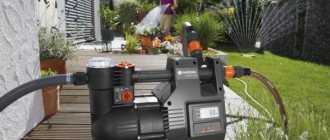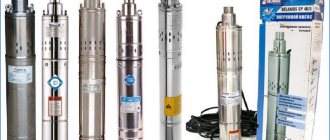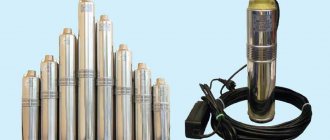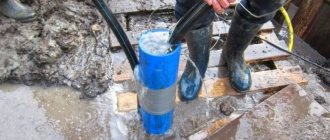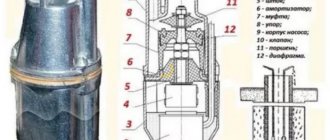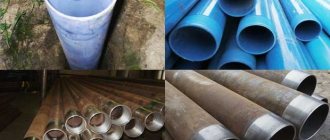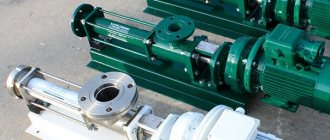How to remove a pump from a well
How to get a pump out of a well with your own hands
One of the most popular sources of water supply in household plots is your own well. It can be either shallow (the so-called “sand well”) or reaching deep horizons (an artesian well or “limestone well”). Deep submersible pumping devices are often used to lift water from wells. They work in the confined space of the casing. The distance between their outer surface and the inner edge of the well usually does not exceed a centimeter.
From time to time, for various reasons, equipment can get stuck in a well. Every owner of an autonomous water supply source should know how to remove the pump from the well.
How to remove a pump from a well
Sources of stuck problems when lifting
The option where submersible equipment can become jammed in a well due to its size is simply impossible. After all, the pump model (with the required dimensions) is selected even before lowering into the casing. Therefore, problems arise, as a rule, when forced to lift an already operating unit.
The submersible pump rises to the surface:
- in case of breakdown, to troubleshoot;
- for planned preventive maintenance;
- in case of replacement with new equipment;
- when you need to change the flushing unit to a permanent one.
A specialist knows well how to get a pump out of a well if it is stuck there. Professionals regularly lift jammed equipment, so they solve such problems quickly and efficiently. But the cost of their services is quite high. Let's look at how you can save family money and remove the pump yourself.
When lifting, the cable sagged
Many owners forget to synchronize the steel cable, hose and electrical cable with each other. Therefore, when pulling the pump out of the well by the sling, the power wire may sag if it is not also tightened at the same time. And a situation often arises when a loop forms on the cable, into which the pump body gets caught.
Attempts to pull out the pump Source allremont59.ru
To fix the problem you need to:
- Place the pump back down to the bottom.
- Align the loop. To do this, you need to swing the cable while simultaneously tightening the cable.
- Carefully resume lifting, making sure that the wires and hoses also leave the casing evenly.
To avoid a similar problem in the future, it is necessary to synchronize the electrical cable and cable with each other. The easiest way is to use clamps, connecting the sling and the wire along the entire length in increments of 1-1.5 meters. And if necessary, then connect the water hose to them in the same way.
Siltation of the well
If the well has a sandy bottom, then over time the equipment will become silted. This most often happens when preventative maintenance is neglected for many years. After all, the hydraulic structure must be cleaned annually.
If for this reason the pump is stuck in the well, it can be very difficult to pull it out. Because silt sediments tend to turn into stone over the years. And when it has hardened long ago and firmly, you will have to spend a lot of time to tear the equipment out of captivity.
Well on the site Source homeli.ru
First you need to try to pull the pump out of the trap using little force. It is necessary to alternately tighten the cable and release it again. At the same time, try to swing it from side to side.
If attempts fail, you will have to wash out the mud trap. To do this, a stream of water under pressure is supplied into the casing pipe. Simply, a hose is lowered to the bottom and the water is turned on. Deposits can soak from 2 hours to 2 days.
Periodically you need to try to pull out a stuck pump using the method described above. Don't forget to swing the cable. And to effectively and quickly wash away silt deposits, an additional pump installed on the surface will help. It will create the necessary pressure, which will help destroy solid deposits.
See also: Catalog of companies that specialize in engineering systems (heating, water supply, sewerage and others) and related work
If the well is in limestone
The most problematic case, since the rock contains a lot of salts, which, when interacting with oxygen, give a solid sediment. Moreover, these deposits accumulate not only on the walls of the well, they cover the housing of the submersible pump. And the thickness of the layers often reaches several centimeters.
Food grade citric acid Source ytimg.com
Increasing the size of the pump leads to it getting jammed in the casing pipe. And until these deposits are removed, it is not possible to move the pump from its place. This cannot be done mechanically. And if the pump is stuck in the well, household chemicals will tell you how to get it out.
Possible actions:
- Direct a strong flow of water created by an additional surface pump onto the submersible pump housing. This will help with minimal deposits.
- Fill the well with water in which acetic or citric acid has previously been dissolved. The method is only suitable if the pump is completely replaced with a new one. Because together with lime deposits, the acid will damage the inside of the pump.
- Dissolve descaling agents in hot water and pour the resulting liquid into the well. In this case, experts recommend turning on the pump and looping the flow.
It should be said that it may not work out at once. Sometimes you need to repeat all the steps a couple of times. And this will be very expensive. For example, for one rinse with descaling agents, the latter requires at least 20 packs.
Household chemicals for wells Source branding.whim.ru
Damage to the well walls
The walls of the casing pipe may have defects. Such as dents or rough internal welds. The pump may get caught on such an obstacle when being lifted. Let's consider how to pull the pump out of the well in this case.
It is necessary to change the position of the equipment inside the pipe. To do this, begin to rotate the cable in any direction. In this case, you need to play off the latter a little, and then try to pass the problem area.
It should be said that if the pipe is severely deformed, when its internal diameter is smaller than the dimensions of the pump, even a professional cannot cope with the situation. In this case, only a complete replacement of the entire casing structure in compliance with the recommended technological standards will help.
How to get the unit if the cable breaks
This is a problem in which owners abandon equipment right in the trunk and lower new ones there. Of course, this can be done if the unit fell to the bottom and sank. And the depth of the mine allows water intake to be higher than before.
When the break occurs above the water level, the unit will still have to be removed. You need to make a special device yourself. By analogy with a mixer or a kitchen whisk, we twist a spiral from the fittings with a sharp end slightly larger than the pump itself. We lower it into the well and weld the rod, immerse it again and attach another rod. So all the way to the bottom. The armature is needed to twist the spiral and grip the device. If the device fails to hook, after rotational movements the rest of the cable will twist onto the trap and the pump will rise.
Important: to avoid problems with cable breakage, from the very beginning it is selected with a sufficient margin of safety. A safety bolt is installed in the coupling with the unit.
What not to do
- Pull forcefully on the hose or cable. They can come off.
- Continue operating the pumping equipment. This will make the situation worse.
- Start lifting the pump without finding out the reason why it is stuck.
- Work with the power cable connected to the pump connected to the socket.
Common mistakes when getting it yourself
A short list of what you should never do:
- Use significant force if equipment gets stuck. This will lead to even more jamming. Or to a cable break with all the unpleasant consequences that were described earlier.
- Use assault cats. This usually leads to the fact that both the stuck pump and the device with which they tried to hook it remain in the casing.
- Attach a crowbar to a rope and try to break through the blockage. When this piece of iron falls into the well, there is no hope for further use of the latter.
Emergency
Getting a pumping device stuck in a well is, to put it mildly, not a pleasant situation. It usually occurs when trying to lift the device to the surface for routine maintenance or repairs. As a result, a stalemate arises: the pumping equipment does not work and it cannot be repaired either, because there is no access to it.
In some cases, you will be able to independently remove the pumping equipment from the well without damaging it, but sometimes you have to say goodbye to the pump. In the most extreme situation, the water well is completely out of order.
Getting a pump stuck in a well is an emergency
Briefly about the main thing
The main thing in such trouble is to remain completely calm and not make sudden movements. The latter should generally be smooth and without excessive effort. Otherwise, you can jam the equipment even more in the casing.
It is necessary to loosen the tension, lower the pump slightly in the pipe and by all means force it to change position. Perhaps it was skewed or it got caught on some defect inside the well. But if all attempts lead to nothing, then you will have to turn to professionals.
Ratings 0
Types of waterproofing
Moisture is the enemy for builders. If water penetrates into structures, they will quickly become unusable. The same goes for the pool. There is water inside it, but it should not penetrate the walls. Therefore, the entire structure must be reliably protected. For this, two types of waterproofing are used:
- external;
- internal.
The outer layer is required to protect the pool bowl from moisture penetrating from the surrounding soil. For this purpose, special additives are used that are mixed with cement. Therefore, external waterproofing is carried out at the construction stage. Internal moisture protection covers the bowl itself and protects against penetration of water poured into the bowl into the supporting structures. It is performed before finishing.
Factory and homemade equipment
To remove casing from a deep well, professionals use factory-made equipment.
It is characterized by such nominal parameters as pressure in MPa, stroke force - forward and reverse in force, maximum torque in kN/m, maximum clamping or extraction force in force, angle of rotation of the clamps, weight in kg, dimensions in mm, range of diameters of the pulled out pipes
The installation consists of a base plate with a stationary gripper and two hydraulic power cylinders installed on it, an upper plate, a movable gripper with which pipes are clamped
The hydraulic return cylinder rods are combined with supports equipped with a crossbar on which the top plate rests. To clamp the support column, this plate has a special movable gripper. Both fixed and movable grips are 3-wedge jaws, internally threaded and placed in a cage.
Hydraulic cylinders are connected to the pumping station. In the event of an emergency situation when there is not enough force to remove the pipe, use a clamp wedging device. The tension may not be enough if, due to unforeseen circumstances, additional friction forces appear between the pipe body and the walls of the well.
The equipment is installed on the casing stand and the latter is clamped using a movable gripper, and then lifted. The lift is equal to the stroke of the pistons. The next step is to fix the pipe with a fixed grip and return the top plate to its original position. The pipe is removed by repeating these steps. While the riser is being drawn out, it is supported by a crane.
With the help of such equipment, casing pipes are pulled out of the ground, the top of which is almost invisible, since the installation has a low pick-up. Another advantage of the mechanism is the ability to lift steel pipes, the standard sizes of which are in a wide range.
To dismantle small-diameter pipes on your site, you can make suitable equipment yourself. For this you will need 2 channels for the racks, a drum for the cable, a bearing with an internal diameter of 40 mm, a cable, and a handle.
Two supports are made, about 1 m high and approximately 0.6 m wide. They are shaped like the letter T when tilted. A bearing is attached to the uprights at the top, and an axle is passed through it. The drum and handle are attached to the axis.
The cable is wrapped around the pipe and the drum begins to rotate. The pipe gradually emerges from the ground. If a plastic product is to be dismantled, a special clamp is used.
As the pipe is removed, the cable is lowered lower. When the structure has a significant length, a special device is used - a jig - to hold the column while moving the cable to a new position.
Work production technology
Before you remove the failed pump with your own hands, you need to prepare the necessary materials and tools. Their list will be given below. After this you can start working.
If the unit has fallen to the bottom along with the hose, then the procedure for performing rescue measures is as follows:
- A rod called a “cat” is used. This is a steel hook, the end of which must be sharpened.
- Then the end of a steel wire is electrically welded to the cat.
- The second end of the wire rope is tied to the crane boom.
- The hook is lowered into the hole, making rotational (like screwing in a screw) movements. This is necessary to hook the hose. Usually such work has to be done blindly.
- If you manage to hook the hose, you can try to remove the pump unit with a lift. Lifting must be done slowly, otherwise the engagement may break.
It is recommended to take insurance when performing work. There is no need to skimp on a metal cable, since if the quality of the material is poor, it will simply break. Therefore, you need to buy a high-quality stainless steel cable.
When removing the pump, do not use a cable made of several parts. During lifting, the joints may burst and the unit will get stuck in the well.
For prevention, buy a pump with the smallest diameter possible, then the possibility of the unit jamming during lifting will sharply decrease. Such models are more expensive than conventional units, but if you skimp, you will have to drill a new well in the event of an accident. It is recommended to install protective equipment over the well; this will prevent foreign objects and debris from getting into the well.
What to do if the pump gets stuck in the well
Getting a pump stuck during lifting, as already mentioned, is not such a critical situation, and if lifting is not carried out by professional well service specialists, then the first thing to do is be patient and pull yourself together; panic in this situation can only aggravate the problem.
A simple analysis of the situation will help you quickly determine the causes of equipment failure and choose the optimal way to solve the problem. To do this you need:
- find out the total installation depth of the pump;
- approximately determine the depth of the jam;
- analyze how tight the cable is, determine whether the pipeline and pump are disconnected and the integrity of the power cable.
- inspect the head of the casing pipe;
- prepare the necessary tools for work;
- clear the area of foreign objects.
This algorithm of operation makes it possible to significantly reduce the time required to prepare for lifting equipment and prevent larger mistakes in the future.
Preparing to dismantle the wellbore
Knowing about possible difficulties, you should prepare for the process thoroughly.
The first step is to determine the weight of the product, for which:
- measure the well depth, pipe diameter, wall thickness;
- open the directory and, focusing on the diameter and wall thickness, find the weight of 1 linear meter. m;
- multiply the found value by the depth of the shaft and obtain the required mass of the pipe.
This value will be the basis when choosing a winch based on traction force. If the figure turns out to be significant and there is no winch with such a traction force, then the only option is to order a crane. When deviations from the calculated value are insignificant, a conventional winch will do.
How to prevent pump lifting problem
Pulling a deep well pump out of a well with your own hands if it comes off is not at all difficult if you follow all the recommendations of specialists.
The catchphrase is: “Forewarned is forearmed.” To prevent unpleasant situations from occurring, you need to follow a number of simple rules that can save equipment, time and money.
- Work only with strong cables. You can't skimp on this item. Choose quality products and fasteners.
- The hose must be intact. Buy one of sufficient length, even if the one included in the kit does not meet the required parameters. This will reduce the risk of breakage significantly.
- Choose the right size. The unit should be one third of the diameter of the pipe. Otherwise, congestion during lifting cannot be avoided.
- Set the header. This will ensure “protection” of the well from unwanted “guests”: garbage, bottles, stones, boxes.
What to do if the pump cannot be removed
If the electric pump cannot be removed to the surface after all operations (it has become detached from the pressure pipeline, hose with cable), proceed in the following ways:
They continue to use the well source. The bodies of most centrifugal electric pumps are made of stainless steel, and the internal parts are made of polymers or corrosion-resistant metals. The materials are designed to supply drinking water, so the presence of fallen electric pumps at the bottom of a well for many years is unlikely to affect its quality.
The greatest danger to humans is oil, which is present in the mechanism of almost all pumping units; over time, it can leak through a damaged housing. Also, stainless steel in budget models, usually of low quality, can become rusty over time, affecting the quality of drinking water.
The body of the vibration pump is made of aluminum, which is not susceptible to corrosion, the internal parts consist of rubber and steel, and the mounting bolts are also steel - they are susceptible to corrosion over time.
The well is being mothballed and a new one is being drilled. If the owner cares about his health, the service life of the old well source is coming to an end, you can drill a new well relatively inexpensively - in these cases, the old one is mothballed or liquidated.
Breaking an electric pump with a drill. The operation is permissible if the pump is stuck in deep artesian wells with internal steel casing and the pressure pipe is torn off, if the unit prevents the source from filling with water. It will not be possible to push the electric pump deeper - a standard artesian has a tapering channel at the bottom.
After the electric pump is destroyed by a drill, its small parts fall into the artesian water basin through a filter pipe that does not have a lower cap. Over time, the oil will wash out and small parts will sink to the limestone bottom.
Rice. 14 Example of removing a pump along with a casing pipe
